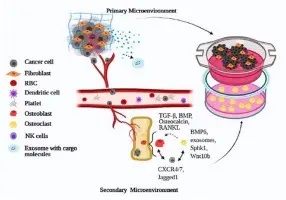Cancer development has always been seen as something to progress in a rapid and uncontrolled fashion, but this view may be wrong. New research suggests that cancer dormancy is a key time for tumor growth.
- New research indicates that cancer dormancy is a key moment in tumor progression
- The analysis concerned the RNA produced by inactive and proliferating cancer cells
- Scientists have shown that some small RNAs can be measured in urine and blood samples. They are currently trying to develop new diagnostic tools to detect these molecules
When a tumor begins to show symptoms, the patient seeks treatment – which usually involves resection of the tumor. Surgery is often successful, but the cancer may come back in some patients. At this point, he is often treated with hormone therapy and chemotherapy. But even these treatments don’t always mean the end of the disease. In some patients, cancer returns after a “dormancy” period.
While dormant, which can last for several years, the patient will often have no symptoms and the tumor will not be detectable with the usual diagnostic tools. Until recently, experts knew little about these periods. However, recent research by a group of scientists suggests that cancer dormancy is a key time for tumor progression.
The dangers of cancer dormancy
To understand why this “dormant” state is useful for cancer cells, it is important to investigate the factors that can halt tumor progression. Cancer cells face three major challenges in their survival and growth. First, they have to trick the immune system into killing most cancers. Second, they must survive cancer treatments and third, they must attack neighboring organs and generate metastasis.
Cancer dormancy is essential to meeting all of these challenges. While dormant, cancer cells change their genetic makeup and prepare for the next stage of development. Without dormancy, cancer cells would not be able to survive in the new environment or would become immune to attacks by the immune system. Therefore, it is important to learn how to detect dormant cancer cells and how to kill them.
However, detecting inactive cells is not easy
Dormant tumors are often small and asymptomatic, making patients unaware of them. Also, dormant tumor cells are in a slow metabolism mode. So even some diagnostic techniques, such as PET scanning, often overlook inactive tumors.
New research is shedding light on the characteristics of dormant cancer cells. The study, in collaboration with the BC Cancer Agency in Canada, focused on RNA produced by inactive and proliferating cancer cells. RNA is a very important molecule that carries genetic information from DNA to proteins.
Scientists have shown that some small RNAs can be measured in urine and blood samples. They are currently trying to develop new diagnostic tools to detect these molecules. If they are successful, it will be possible to create blood or urine-based diagnostic kits to help doctors identify dormant tumors before they become too large to be treated effectively.
Once dormant cancer cells have been identified, they should be eliminated. Unfortunately, because these cancer cells are metabolically inactive, they are less likely to be killed by conventional chemotherapy, so targeting them is difficult. But let’s hope it’s possible.
Much new research shows that dormant cells can have weak spots. For example, experiments have shown that some NSAIDs can stop dormant cancer cells that metastasize when “awake”. If these results are confirmed in clinical trials, it will soon be possible to offer patients therapies to target dormant cancer cells.
Based on: independent.co.uk










